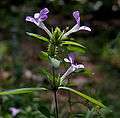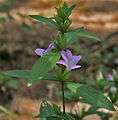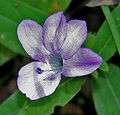Barleria cristata
| Philippine violet | |
|---|---|
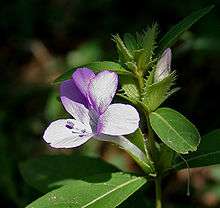 | |
| Scientific classification | |
| Kingdom: | Plantae |
| (unranked): | Angiosperms |
| (unranked): | Eudicots |
| (unranked): | Asterids |
| Order: | Lamiales |
| Family: | Acanthaceae |
| Genus: | Barleria |
| Species: | B. cristata |
| Binomial name | |
| Barleria cristata L. | |
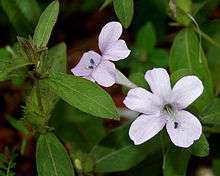
Barleria cristata (Philippine violet, bluebell barleria or crested Philippine violet), is a plant of the Acanthaceae family.
Distribution and habitat
It is native to a wide area ranging from Southern China to India and Myanmar.
Cultivated as an ornamental plant in villages and gardens, it has become naturalized in Hawaii, where it grows in dry habitats. In Fiji, where it is known as "tombithi" and in Christmas Island (Indian Ocean), the shrub grows also as a ruderal species along roadsides and disturbed areas from near sea level to about 100 m.[1]
Description
It grows as a shrub 60 –100 cm tall. The leaves are dark green on the upper surface and pale green on the lower surface. They are elliptic to narrowly ovate. The flowers are about 5 cm long, funnel-shaped in violet, pink, or white color. The fruits are about 1.5 cm long ellipsoid capsules. Thy become glabrous and glossy at maturity.
Different views and aspects
-
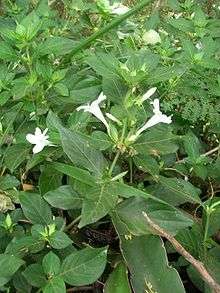
Barleria cristata shrub.
-

at Ananthagiri Hills, in Rangareddy district of Andhra Pradesh, India.
-

at Ananthagiri Hills, in Rangareddy district of Andhra Pradesh, India.
-

at Ananthagiri Hills, in Rangareddy district of Andhra Pradesh, India.
-

at Ananthagiri Hills, in Rangareddy district of Andhra Pradesh, India.
-

at Mastyagiri, Nalgonda District of Andhra Pradesh, India.
Uses
Known as อังกาบ, this plant is used in Thailand as a traditional herbal remedy. It allegedly acts as a tonic, diuretic and blood purifier.
In Tamil Nadu in South India, it is known as December Poo or December Flower as it blooms in December and is normally strung into garlands of flowers for women to wear in their hair.
References
| Wikimedia Commons has media related to Barleria cristata. |
| Wikispecies has information related to: Barleria cristata |
